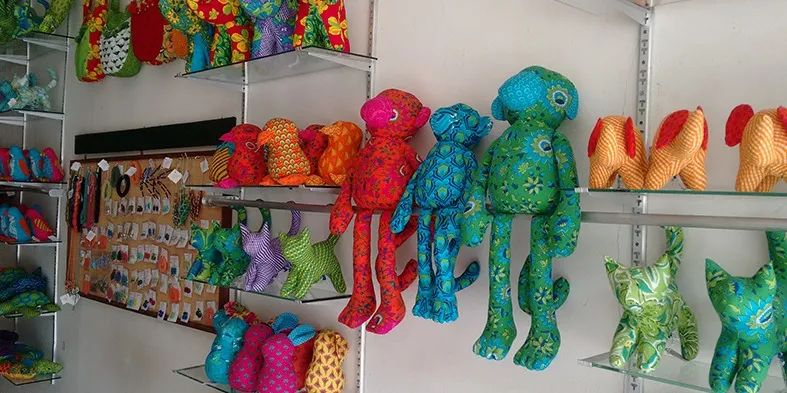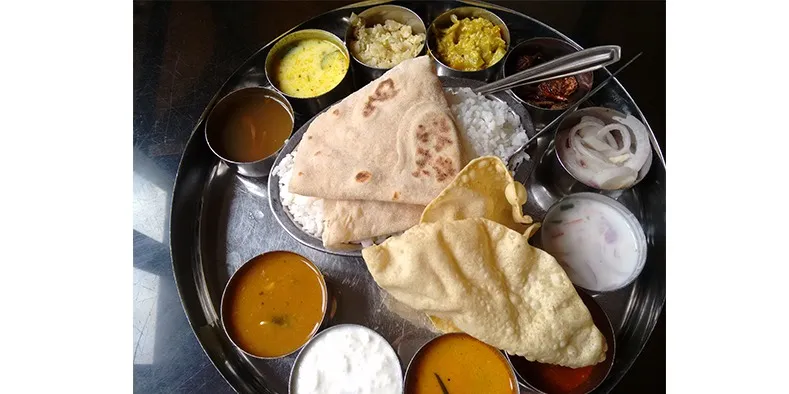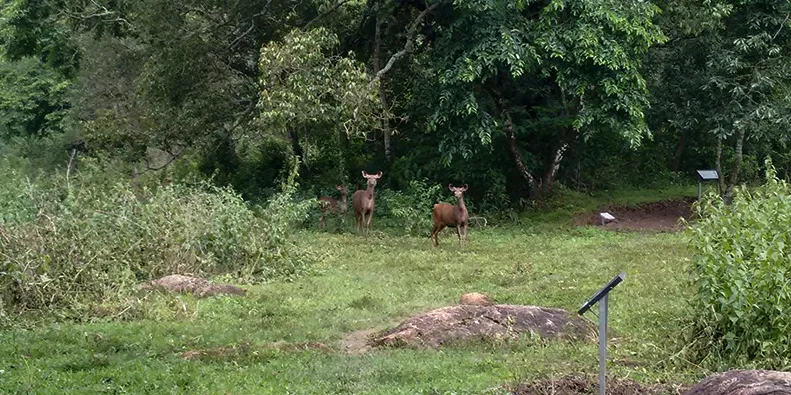

[Travel series] A Rendezvous with the Tigers of Periyar
At the start of my Kerala trip, I trekked to the Thiruvananthapuram Zoo with the sole purpose of seeing the resident tiger that had inspired Yann Martel to write Life of Pi. The zoo’s Royal Bengal Tiger is cast as Richard Parker in the Booker Prize winning book that was subsequently made into an Oscar winning movie. Running late for my onward train, I had to cut short my visit to the zoo, resulting in a missed meeting with the majestic cat. Determined to make amends, I followed the tiger trail to Periyar Tiger Reserve in the Western Ghats. Read on to find out about my rendezvous with the enigmatic Richard Parker and my travels through this section of the Ghats.
.jpg?fm=png&auto=format)
Figure 1 A Kalaripayatu artist in action. Picture courtesy, the artists of Mudra Kalari Center
Exploring Thekkady
Thekkady, the principal town in the region, has a unique and laid-back charm. Here are some reasons why I recommend that you spend a couple of days exploring the many delights that Thekkady offers.
A wide variety of activities
• Dance and martial arts performances: The Mudra Cultural Centre hosts evening performances of Kathakali - the traditional dance form of Kerala - and of Kalaripayatu – the oldest martial arts form in the world. Expect to watch the artists perform some gravity defying moves and play with fire during the Kalaripayatu performance. While over at the Kathakali show, the demoness Nakratundi tries to lure the God Indra only to have her advances rebuffed and punished. Both shows are quite entertaining and allow you to experience the rich cultural heritage of the state.
• Tribal experiences: Several tribal communities such as the Manans and Palians call the region home and catching a glimpse of their lives can be a fascinating experience. You can sign up for the ecotourism program to visit tribal hamlets in the heart of the jungle, check the tribal heritage museum out, or watch traditional tribal plays and performances at the Vanashree auditorium.
• Spice Plantations: Thekkady borders Kumily, known as the ‘plantation town’, with plantation referring to spice farms. Kerala was at the heart of the ancient maritime trade of Indian spices and a tour through the spice plantations in the region can help you understand why. The small, green Cardamom grows in abundance in the hillsides as does the ‘black gold’ pepper.
Warm and helpful locals
Thekkady was home to some of the friendliest people I met on my trip. The staff at the Reserve (more about the reserve later) were extremely helpful, even lending me a pair of anti-leech socks (for which I am eternally grateful, given my morbid fear of leeches). The Kalaripayatu performers gave me a private audience on the day after the show give me a more in-depth understanding of the art form. The server at the road-side food stall would wipe down the table with a flourish especially for me, and the people over at the family-run laundry business ensured that I had a backpack full of clean clothes in time for my onward bus. A solo female traveller, I not only felt safe but also very welcome in the town.

Figure 2 Ishtiaq's shop on the road leading to the Sanctuary sells products made by marginilized women supported by Blue Mango
A walker friendly town
It is likely that you will stay in adjacent town of Kumily (that houses several budget stay options) and make your way to the Tiger Reserve and Thekkady town. While there are buses and auto rickshaws that connect to Thekkady and the Reserve, the 3 KM walk along the Thekkady Bypass road is very pleasant. The various activities in Thekkady town are also a mere stroll away along bustling shops and inviting eateries. In no time, you will be familiar with the lay of the land. Lost? Turn to Google maps or simply ask the helpful locals.
Dining options that suit all budgets
A walk on the bypass road or into Kumily town will reveal a pick of restaurants and eateries to choose from. You can splurge on the European fare of Our Place or visit the Grandma’s café for vegan options, or head to Hotel Ariya Bhavan right across the bus stand for some Indian fare. Roadside eateries pop up during the evening, and simply follow the locals to discover delicious Malabar parathas and curry options.

Figure 3 A vegetarian thali meal at Hotel Ariya Bhavan
Reaching Thekkady
My travel to Thekkady was quite an enjoyable adventure. I was based in Alleppey from where I boarded a long-distance ferry at 7 AM (for a very small fee of INR 15) to Kottayam. The ferry passes through picturesque villages and backwaters framed by nodding palm trees, and the locals – including children getting to school - use it to commute. The ferry’s last stop is the Kanjiram jetty. A short walk from the jetty will take you to buses heading into Kottayam town. Head to the bus stand in Kottayam to catch a long-distance bus to Kumily. There may be shorter ways of reaching Thekkady, but none are so scenic and enjoyable! For my onward journey, I took a bus from the stand, to Munnar. The bus stand in Kumily has two enquiry counters, one run by the government and one that serves private operators, so do check out both for any information you may want.
Periyar Tiger Reserve
The principle attraction of the region, the Periyar Tiger Reserve is situated in the Cardamom Hills and Pandalam Hills of the Western Ghats and stretches over 925 square KM. The sanctuary houses the Periyar Lake, formed in 1895 with the construction of the Mullaperiyar Dam across the Periyar River. In 1933, the Travancore State declared the area around the lake to be a game sanctuary. Over subsequent years, additional areas were added, and the expanded region became the Periyar Wildlife Sanctuary. In 1978, the sanctuary was bought under Project Tiger, set up to conserve the endangered tiger population in India. In addition to being home to the Tiger, the Reserve has several species of animals such as the Elephant and the Nilgiri Tahr, natural vegetation of evergreen and semi-evergreen forests, and a variety of birds, flowers and butterflies. Here as in Yeats’ poem, ‘peace comes dropping slow’, and you will be hard pressed to find greener, more serene forests in the mountains to trek through while experiencing the many bounties of nature.

Figure 4 From the boat safari on Periyar Lake
Activities in Periyar Tiger Reserve
The authorities of the Reserve run several community centred eco-tourism activities that have the dual benefit of involving the local community and serving as a source of revenue for public welfare. Some of the activities that you can choose from are:
• Nature Walk: 2.5 hours 4-5 KM trek conducted by a tribal guide
• Border Trekking: A full day trek covering 15 KM over tough terrain
• Bamboo Rafting: A full day of trekking and rafting on bamboo rafts
• Jungle Scout: 3 hours of night trek
• Tiger Trail: Camping inside the forest for a night or two
Get more details on these treks and others on the Reserve’s site. The fee for each trek varies but they need a minimum number of people to run the program, so it helps if you are in a group. For booking any of the programs, you can visit the office near the Ambadi Junction about 1 KM from the park entrance. You can also book your chosen activity on-line.

Figure 5 The sambars stopping to say hello in the Periyar Tiger Reserve
I opted for the following programs:
Boat Safari on the Periyar Lake: The Periyar Foundation operates 90 minutes long boat trips on the lake, at 7:30 AM, 9:30 AM, 11:15 AM, 13:45 and 15:30. I was on the 7:30 AM boat, having been told that early mornings and late afternoons are the best times to sight animals. I saw birds by the dozen, with darters sunning themselves on dead trunks, flashes of colours marking kingfishers hoping for some breakfast, and peacocks by the lake shore casting haughty looks at the boat. A family of otters frolicked by the bank, and the baby otter broke away, only to come squealing back. The gorgeous views of a sky overcast with glowering Monsoon clouds, and the morning dawning in shades of green over still waters, more than made up for the complete lack of any tiger sightings.
Self-guided Pugmark Trail: For INR 100, I trekked for a couple of KM in the forest along the marked Pugmark Trail. A self-guided tour, the path has informative placards describing the flora and fauna of the sanctuary. Walking through the mysterious forests alone was a superlative experience complete with sightings of the Great Indian Malabar squirrel, startled hornbills, and an entire family of sambar that was sharing my path. Towards the close of my trek, the afternoon sky darkened, and the rains and mist started closing in. I hastened my pace, hoping that Richard Parker, the feckless tiger, didn’t choose that moment to honour our date!
This travel post is a part of Aao hostels fellowship travel series.

![[Travel series] A Rendezvous with the Tigers of Periyar](https://images.yourstory.com/production/document_image/mystoryimage/7o7wgu2j-IMG-20170923-WA0008-(1).jpg?w=1152&fm=auto&ar=2:1&mode=crop&crop=faces)




